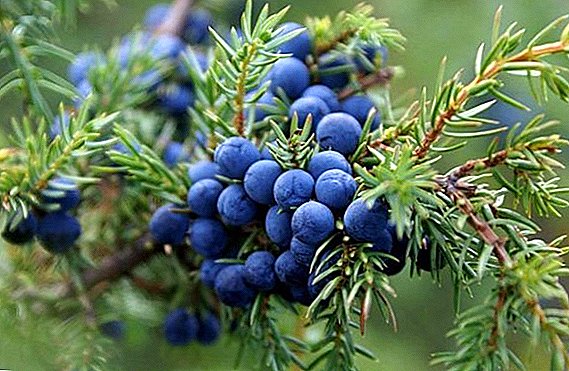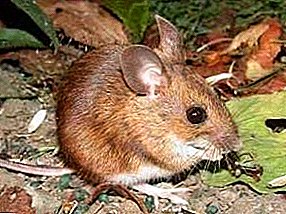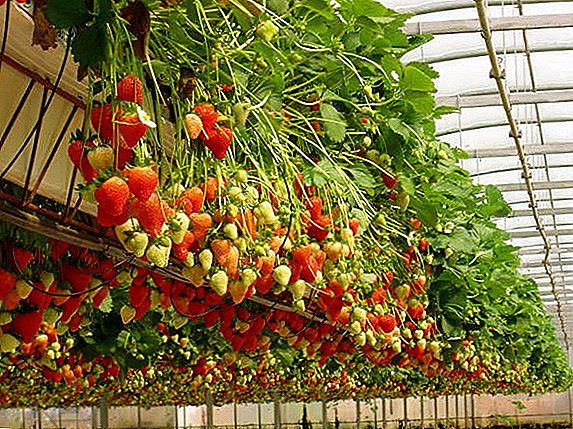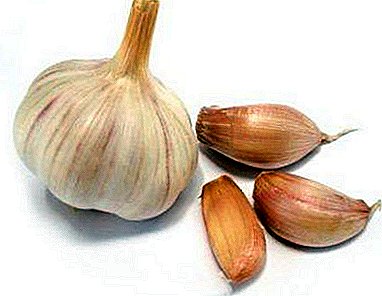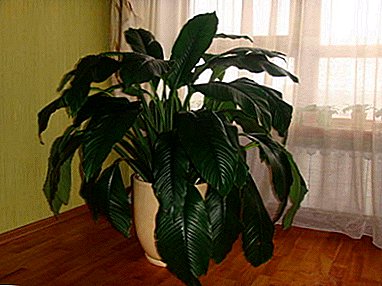
Few people know the spathiphyllum under this name, but “female happiness” is its more famous name. Like other plants, it has many subspecies.
The largest of these is the spathiphyllum sensation or sensation. It is about him and will be discussed in this article.
You will read its description, about the subports, see the photo. Learn how to properly care.
Detailed description and photo
This variety was bred by Dutch originators, so that you can plant trees and trees in spacious spaces that do not have bright light. The sensation is presented in the form of a large tall bush plant.. The stem of this variety is absent.
The leaves of this variety are basal, ribbed, elongated lanceolate form. Represent a bunch growing straight from the soil. They can be from 50 to 80 cm in length and from 30 to 40 cm in width. Their color is bright green.
On the sheets of the Sensation you can observe yellow and white stains.. The flower is white with a flag-shaped form of a petal, inside of which is a large spike of yellow-green shade in size not inferior to the leaves.
Below you will see a photo of a flower:



What is the difference from other species?
It is distinguished from other varieties by its gigantic size, because other species of spathiphyllum reach no more than 50 cm. Another distinctive feature of it is a huge white flower, resembling leaves in size. And the most important thing is that this plant develops well in darkened rooms.
History of
They attribute this variety to the family of Aroids. Place of growth - the tropics of America and East Asia. This evergreen perennial has more than forty species. In this case, the breeders constantly display new varieties.
Subsorts of this species
With yellow variation:
- Strauss;
- Sunny Sales;
- Milk;
- Haiti.
With white variegation:
- Domino;
- Picasso;
- Gemini.
Bloom
When and how?
 Flowering lasts a long time, especially with proper care. Its beginning comes in the middle of spring and ends with the arrival of autumn. For a duration of 6 to 10 weeks. If you properly care for the flower, then it may bloom again in winter.
Flowering lasts a long time, especially with proper care. Its beginning comes in the middle of spring and ends with the arrival of autumn. For a duration of 6 to 10 weeks. If you properly care for the flower, then it may bloom again in winter.
The flower during flowering has a beautiful white blossom and looks like a sail. The leaves during flowering have a juicy bright green color.
Before and after flowering
Despite its size, Senseation is a picky plant and does not require special requirements for its care. Simply carry out the following procedures:
- Do not contain a plant in drafts - this will adversely affect its development.
- Spraying: in the winter once a day, in the summer - three times.
- Wiping leaves.
- Produce abundant watering, while avoiding stagnant water.
- Produce top dressing during active growth and flowering.
- In the summer, arrange airing, bringing the flower to fresh air in a shaded place.
- To produce pruning plants.
- After flowering remove wilted inflorescences.
What if there are no buds?
There are a number of reasons why the plant does not bloom.:
- improper watering;
- improper feeding;
- high humidity of the room;
- unsuitable pot;
- lack or excess of light.
To make a plant to bloom, it is necessary to identify the cause and eliminate it. And for this you need to know the basic rules of care and the needs of the Sensation.
Step-by-step home care instructions
Choosing a place
 Since the spathiphyllum sensation is a shade-loving plant, the young plant can be grown on the northern and eastern windows. An adult, for obvious reasons, will not be able to grow on the window sill, which is why they can be placed on the floor near the window.
Since the spathiphyllum sensation is a shade-loving plant, the young plant can be grown on the northern and eastern windows. An adult, for obvious reasons, will not be able to grow on the window sill, which is why they can be placed on the floor near the window.
The main condition is to prevent direct sunlight from which the leaves will suffer.
What should be the soil?
For planting, you can buy ready-made soil in a flower shop for aroid plants. You can also prepare it yourself, adhering to certain requirements. The soil must be nutritious and have good water and air permeability.
To prepare the soil you need to take:
- 4 pieces of garden land;
- 2 parts peat;
- 2 parts of humus;
- 1 part of sand.
Temperature
Since Spathiphyllum Sensation is a tropical resident, he is very fond of heat and does not tolerate drafts. The room should have a temperature not lower than 18 degrees, but not exceed 25.
The optimum temperature for normal growth will be 22 degrees. During the rest period, the temperature can be reduced to no more than +16.
Watering
The plant must be provided with abundant watering. using soft distilled water at room temperature. It is important to monitor watering. The plant should not dry out or be in waterlogged soil.
In winter it will be enough to water once every three to four days.
Top dressing
 An important part in the care of the plant is fertilizing. The main part of the dressings occurs during the period of active growth in spring and summer. Twice a month it is necessary to water the flower with mineral fertilizers.
An important part in the care of the plant is fertilizing. The main part of the dressings occurs during the period of active growth in spring and summer. Twice a month it is necessary to water the flower with mineral fertilizers.
Organic fertilizer in the form of a solution of bird droppings or cow manure will be an excellent option. In winter, flower feeding is not needed.
Pruning
This procedure is carried out after flowering. Peduncle is cut as close to the roots as possible.. If there are diseased or dry leaves, they should also be cut, and the cuts processed with charcoal.
Transfer
The young plant is transplanted every year, updating the soil to fresh. The best time is spring, until the beginning of growth processes. An adult plant, starting at 4 years old, is enough to replant once every three years, and then only the top layer of the earth can be changed at all. During transplantation, it is important to follow these rules:
- It is right to pick a pot - it should not be small so that the flower is not crowded, but not very large, because in this case only the root will grow to fill the free space, and the plant itself will not bloom.
- Buy or prepare the necessary soil.
- Before planting, cover the bottom of the pot with drainage and, if not, make drainage holes in the pot.
- A transplant is made together with an earthy ball.
Step by step instructions: how to multiply?
Three breeding methods are suitable for this variety:

- Dividing bush - you need to carefully separate the young plants and transplant in different containers. This is the most suitable method for this sort of spathiphyllum.
- Cuttings - cut cuttings from a healthy plant, put them in peat or sand, tighten with a film. Capacity with cuttings placed in the shade and heat. After the appearance of the roots (2-4 weeks), gradually open the cuttings.
- Seeds - rarely used and only by breeders. It is necessary to plant the seeds immediately after harvest. Place them in peat, drag over the film, periodically water and air. Grown up seedlings to plant in separate pots and cover with foil. Before full adaptation, periodically open and air, after removing the film completely.
Diseases and pests
- Aphid and shitovka - you need to wash the leaves with soapy water and cover the soil with a film, after that make a flower shower, wash again in 2-3 days.
- Thrips - spraying of the back side of the sheet with insecticidal preparations will help.
- Spider mite - the plant will save treatment with insecticide and shower.
Of the diseases peculiar to:
- Yellowing leaves - from exhaustion during flowering or lack of watering and feeding. For treatment, care needs to be corrected.
- Dry leaves - low humidity. It will help spraying and rubbing the leaves.
- Drooping leaves - from the lack of watering.
Spathiphyllum Sensation is an immaculate and insanely beautiful plant that will not leave you indifferent. Will delight you with a long and gorgeous bloom for a long time. The main thing - to follow simple rules in the care of him.



